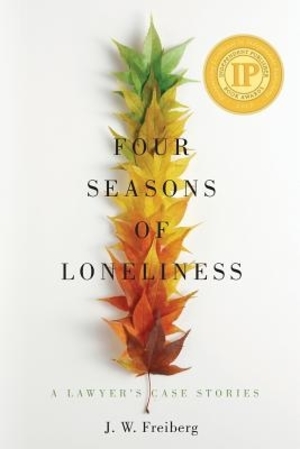After a PhD in social psychology and a JD in law, J. W. Freiberg has practiced as an attorney with a significant focus of cases involving social/psychological issues and the law for over 30 years. This book is the presentation of the legal cases from his career and the chronicle of interviews and meetings with a fourth individual. These four stories are the representation of the “Four Seasons of Loneliness.”
[alert variation=”alert-info”]Publisher: Philia Books
Formats: Paperback, eBook, Kindle, Audiobook, Audible
Purchase: Powell’s | Amazon | IndieBound | iBooks[/alert]
The first case involves a family with unusual dynamics, ultimately causing separation of members resulting in labeling a teenager as a sexual predator and a life of loneliness. The second, not a legal case, is a man who spent 15 years in solitary confinement in China during the early years of the communist nation; he found ways to survive and maintain his sanity. The third was a truck driver who lived in isolated but well-read life, involved in a vehicular accident resulting in death. The final story is of a professor of history, never married, who has studied the history of love and is at the end of his life. Each of these stories presents people who for various reasons and circumstances find themselves with no meaningful human contacts. Freiberg defines loneliness as “the perception of inadequate connections to others.” He identifies it as a sensation much like “hunger and thirst”; he does not equate it with emotion. Others classify loneliness as is an emotional discomfort, an emotional response to isolation and the lack of connections the individual desires. Each individual in this book find themselves without the contacts they need or desire and are seen to deal with that emotional need in different ways.
While the book title suggests an examination of the emotion of loneliness at different stages of life (seasons) it is a presentation of four experiences in the author’s career. After 250 pages spent on these individuals an epilogue ends the book with 9 pages of summary on the part of the author including the suggestions of “being aware of being lonely” and “nurturing and creating connections.” While the presentations of each are interesting and identifies the onset of loneliness (acute to lifelong chronic), as well as the outcomes (dreadfully tragic to exceptionally admirable), they do little but make us aware of a unique spectrum of loneliness the author has been exposed to in his career. At the beginning of the book the author makes clear he did not plan to create “a treatise on loneliness” but to present “a collection of life histories of four clients.” Also, he has modified “specifics of the cases” for reasons of privilege and confidentiality. As much of the book is presented as dialogue (personal) and transcript from testimony, it is difficult to ascertain how much is accurate and how could he recall in such detail events and conversations that occurred during a 30-year career. Assuming a significant amount of accuracy, the stories are interesting, emotion and empathy laden, as well as thought provoking.
[signoff predefined=”Social Media Reminder” icon=”facebook”][/signoff]

